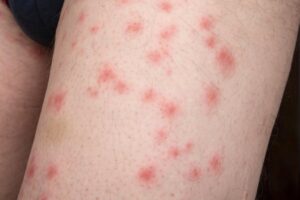How Big Can Bed Bug Bites Get?
Have you ever woken up to find yourself the unwilling donor at a bed bug feast? If so, you might have asked yourself, “How big do bed bug bites get?” It’s a common question with an answer as varied as the people asking it. This article will explore the range of bite sizes, what influences them, and offer tips for prevention and treatment. Let’s dive into the itchy details and how to deal with this tiny but mighty nuisance.
The Size Spectrum of Bed Bug Bites
- Spot the Spot: Initially, bed bug bites may appear indistinguishable from other insect bites – small, red, and itchy. For many, these bites remain tiny, no more than 5mm in diameter, similar to the size of a pencil eraser. But don’t be fooled by their modest start.
- Typical Bites: Most people find that a bug bite is no more than a few millimeters in size. They often show up as a reddened area with a darker spot in the middle where the bug has made a puncture.
- Extreme Cases: On the other end of the spectrum, some individuals may experience bites that swell significantly, expanding to the size of a quarter (24mm) or more. This can be particularly true for those with heightened sensitivity to bed bug saliva, which contains proteins that can trigger an immune response in humans.
- Kills Bed Bugs & Their Eggs
- Surface spray to beds, mattresses and more
- Intended for indoor residential
- Helps to treat deep into cracks and crevices
Factors That Influence Bite Size
Bed bug bites don’t have a one-size-fits-all appearance. The variation in size from one person to another, or even from one bite to the next, can be attributed to several factors:
- Individual Reactions: Just like with foods or pollen, people’s skin reacts differently to bed bug bites. Some people might experience a minor irritation that quickly subsides, while others may develop large, itchy welts.
- Duration of Exposure: How long a bed bug feeds can also impact the size of the bite. A quick snack results in a smaller mark, whereas
bed bugs that feed uninterrupted can cause a larger bite due to the increased amount of saliva injected. - Repeat Offenders: With each successive bite, some individuals may become more sensitized to the bed bug’s saliva, leading to more pronounced swelling with each encounter.

Bed Bug Bites vs. Other Culprits
Identifying bed bug bites can be as tricky as finding the
- Location and Pattern: Bed bug bites are notorious for their linear or clustered patterns, often appearing on exposed skin such as arms, neck, or legs. This distinguishes them from mosquito bites, which are more randomly placed and usually not in a straight line.
- Timing: Unlike mosquito bites that are immediately itchy, bed bug bites can take a few days to manifest fully on the skin, making the connection between the bites and your bed less obvious.
- Associated Symptoms: Additional clues include small blood spots on your bedding or a subtle, sweet, musty odor in your bedroom—both telltale signs of a bed bug presence.
- Kills Bed Bugs and Fleas
- Inhibits Reinfestation Up to 7 Months
- Use indoors in enclosed spaces
- Non Toxic
Mitigation and Prevention
The best way to deal with bed bug bites is to avoid getting them in the first place:
- Regular Inspection: Make a habit of inspecting your bed regularly. Look for signs of
bed bugs themselves—tiny, reddish-brown insects—or their droppings, which appear as small black dots. - Protective Covers: Investing in mattress and pillow encasements can create a barrier that
bed bugs cannot penetrate. - Professional Help: At the first sign of an infestation, it’s wise to enlist the services of a pest control professional.
Bed bugs are notorious for their resilience and can be challenging to eradicate without expert assistance.
You might be interested in: Can Bed Bugs Bite Through Clothes?
When to Seek Medical Attention
Bed bug bites are generally more of a nuisance than a health hazard. However, there are exceptions:
- Severe Reactions: If the size of the bite seems disproportionate to a typical bed bug bite, or if the area becomes excessively painful, it’s time to consult a doctor.
- Infection Risk: Scratching the bites can lead to secondary infections. Signs of infection, such as increased redness, warmth, swelling, or pus, should be promptly assessed by a healthcare provider.
- Allergic Response: In very rare cases, an allergic reaction to bed bug bites can occur. Symptoms may include difficulty breathing, a widespread rash, or swelling of the lips or eyelids. This constitutes a medical emergency and requires immediate attention.
- Bedbug Detection and Protection
- Effective, Heav Duty, Versatile Design
- Use under bed posts and furniture legs
- Bed bugs climb in but cannot climb out
The Itchy Reality
Bedbug bites can range from subtle to surprisingly massive, depending on a variety of factors. Understanding the potential size of these bites, prevention and treatment can help you keep your sleeping refuge safe.
Remember, if you’re dealing with persistent or large bed bug bites, it’s not just about alleviating symptoms. Ensuring your home is bed bug-free is crucial for your peace of mind and health. Regular inspections and prompt action at the first sign of trouble can go a long way in keeping these pesky pests in check.
You might be interested in: DIY Flea Spray for Bed







